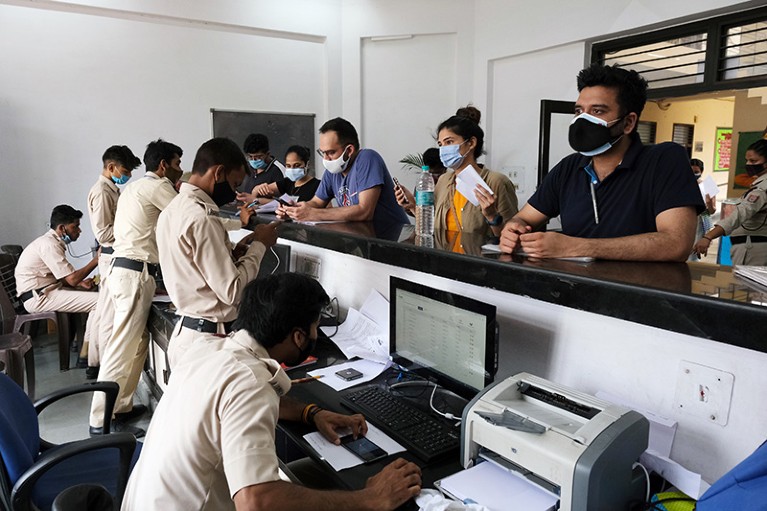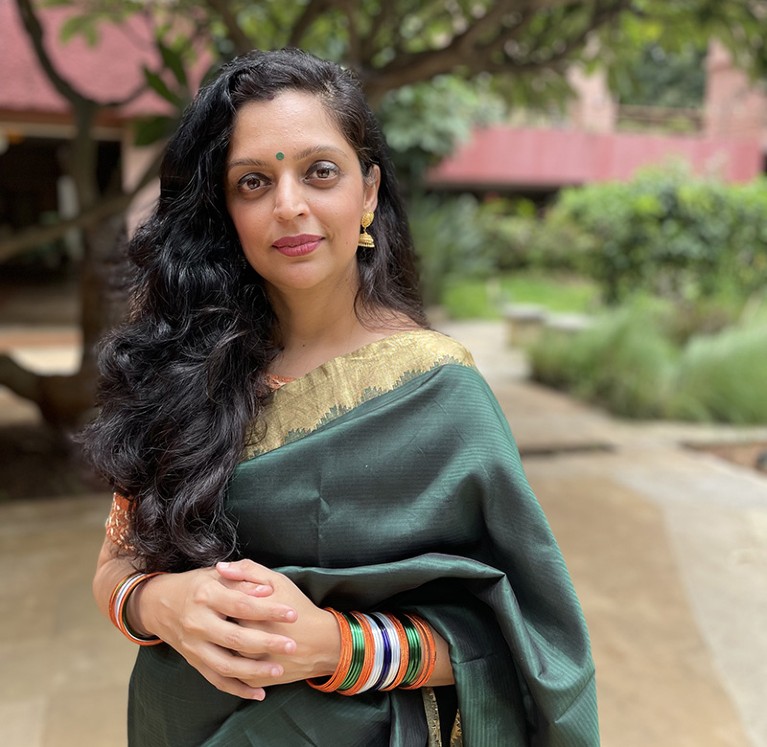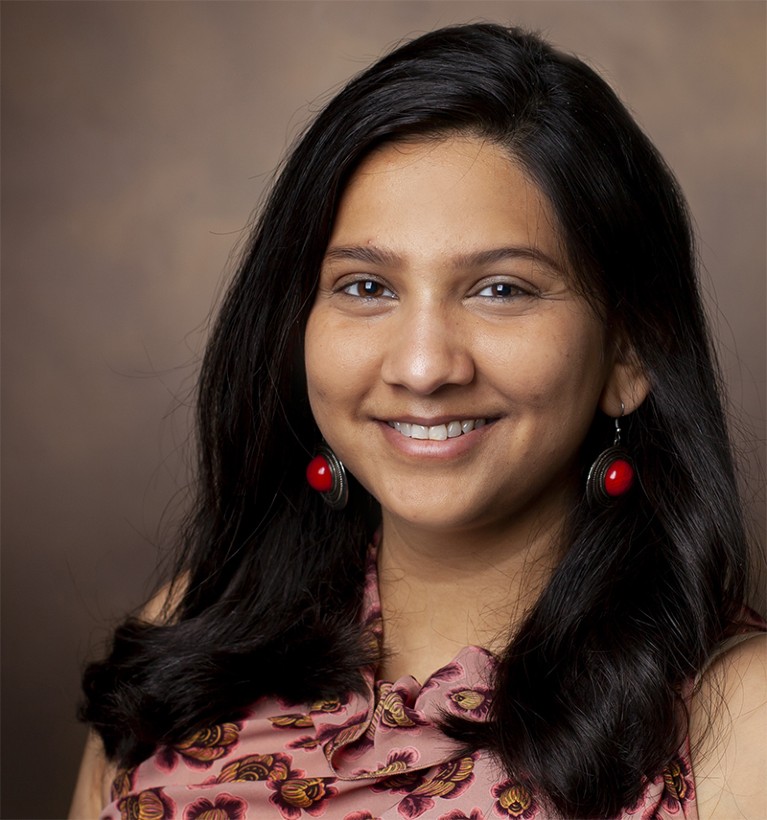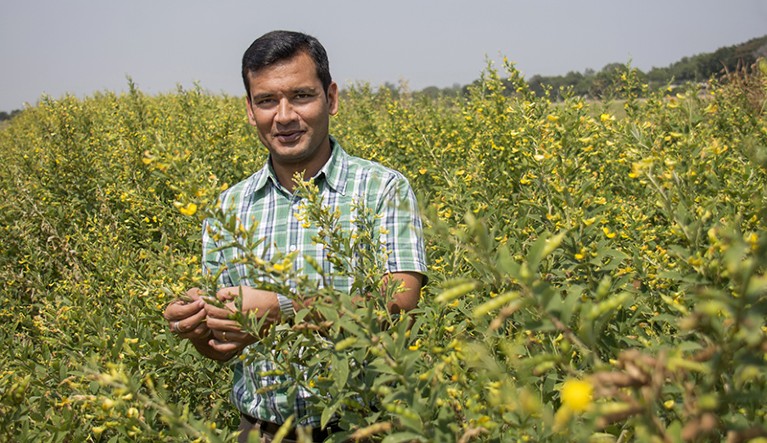
These students registering for COVID-19 vaccinations are among large numbers of people who leave India to study abroad.Credit: T. Narayan/Bloomberg via Getty
In this era of globalization, India, like so many emerging economies, has struggled to staunch its brain drain, the outward flow of many of the country’s brightest academics who seek prominent opportunities in developed nations. A 2023 study of the 1,000 highest scorers in the 2010 joint entrance exams to the Indian Institutes of Technology — a network of prestigious centrally funded autonomous universities based in 23 Indian cities — revealed the scale of the problem. Around 36% migrated abroad1, and of the top 100 scorers, 62% left the country.
The problem has been getting worse. In 2022, the number of Indian students leaving the country for higher education reached a six-year high of 770,000. And a 2021 report2 estimated that around two million Indian students would be studying abroad by 2024. Students typically go abroad in search of academic research training and job opportunities. India’s government spends a relatively small proportion of its gross domestic product on research, just 0.7%, compared with a global average of 1.8%.
The Indian government has set up several schemes to repatriate scholars who went abroad (see ‘Return to India’), and some of them are bearing fruit. Since 2006, more than 550 biotechnologists have returned to India through the Ramalingaswami Re-entry Fellowship, a scheme designed to attract highly skilled Indian nationals working overseas in biotechnology or the life sciences to return to India to pursue their research. About 300 have found permanent positions in India’s science and technology institutes and universities.
The prestigious award, which offers five years’ salary as well as research funding, was launched in 2006 by the government’s Department of Biotechnology. Up to 75 fellows are selected each year. Another programme, the Vaishvik Bhartiya Vaigyanik (VAIBHAV) Fellowship, was established by the Department of Science and Technology in June 2023 to connect the country’s science, technology, engineering, maths and medicine diaspora with Indian academic and research institutions to foster collaborative research and the exchange of knowledge. Each year, 75 fellows are selected in disciplines such as pharmacology, electronics, energy, materials science and quantum technology.
Somak Raychaudhury, an astrophysicist and vice-chancellor of Ashoka University in Sonipat, hopes India’s emerging status as a scientific power will help to stem the brain drain. He cites global collaborations, such as the Thirty Meter Telescope International Observatory, that feature India as a key player. “If some of these projects are fruitful then I think, within 10 years or 15 years, there wouldn’t be much of a reason for Indians to go by default to the United States, or to the United Kingdom, or anywhere else to do their research, and this is where they’re going now.”
But the decision whether to return home or stay abroad is based on a complex mix of personal, professional and patriotic considerations. To explore these factors, Nature spoke to three academics about their motivations for moving abroad, coming home or deciding to develop their career solely in India.
KARISHMA KAUSHIK: Building networking opportunities in India
Executive director, IndiaBioscience, based in Bengaluru.

Karishma Kaushik left India as a physician but returned after switching to research.Credit: Kaushik Balasubramanian
Born and raised in Mumbai, I never had any plans to leave India. I trained to be a medical doctor with expertise in infectious disease at Maharashtra University of Health Sciences in Nashik, including a residency in clinical microbiology at the Armed Forces Medical College in Pune. My country had given me so much, I wanted to stay in India so I could give back. Then, in 2008, I met my partner, who was based in California.
I moved to the United States in the same year and reached a fork in my career. I needed to either go through medical licensing exams in the United States or pursue my interest in research. I chose the latter. After finishing my PhD, I accepted a faculty teaching position at the University of Texas in Austin in 2015. In total, we were in the United States for ten years.
In 2018, our conversations about returning to India were driven largely by a desire to be near our families. But the talk turned to action when I learned about the Ramalingaswami Re-entry Fellowship. I applied and received the award a few months later. The fellowship provides five years of salary as well as research support to start a lab at an Indian university or scientific institute. This salary guarantee made me an attractive candidate to many institutes in the Indian academic ecosystem.
The fellowship was a turning point for me. I was able to start a research lab at Savitribai Phule Pune University, focused on infection biology — and be near family in Pune. I mentored more than 25 students, many of them women, between 2018 and 2023. Although mentoring women in science did not factor into my decision to return to India, once I did return, it felt almost like a national duty for me to share my array of experiences and opportunities with other Indian women in science.
My return wasn’t without its challenges. I left India as a physician with a medical network and returned ten years later as a scientist, with no academic research network in India. I had to get used to how science works here. For example, reagents and materials take much longer to arrive, so it requires a different level of planning and an adjustment to the slower pace of work. In addition, there are very few faculty positions for the number of PhDs produced, so academics are wise to have back-up career plans.
There is a perception in India that if you have trained abroad — and have spent time at a high-profile university, such as Columbia or Baylor — you have a leg up on academics who have stayed in India. In some ways, maybe it helps to have internationally recognized scholars as collaborators or co-authors. But the returning academic must also recalibrate how to work in the Indian academic system. It’s a double-edged sword.
I think the country’s efforts to combat the brain drain are working and should probably be expanded. I hope to help build those efforts in my new role. In April, I became executive director of IndiaBioscience, which is funded in part by the Department of Biotechnology programme intended to enhance the country’s scientific capacity. Since then I’ve wrapped up my university research group.
Working closely with the larger science community in India, I plan to build IndiaBioscience programmes and partnerships to achieve the long-term goals of the organization. One goal is to build a networking database to help scientists make connections in their fields.
SRISHTI NAYAK: Academic culture shocks
Interdisciplinary cognitive scientist studying language, musicality and hearing at Vanderbilt University in Nashville, Tennessee.

Srishti Nayak left India in search of an undergraduate course in cognitive science.Credit: Susan Urmy, Vanderbilt University Medical Center
As a teenager in Delhi, my goal for university was to find a cognitive-science undergraduate programme. But in 2005, there were very few programmes in the world, and none that I knew of in India. I applied to every undergraduate programme I could find online in Canada and the United States, but they were all very new and it was unclear how I could best position myself to conduct research in such a new field.
I ended up getting a degree in cognitive science from York University in Toronto, Canada, in 2010, but I didn’t get much hands-on lab research experience. From there, I went to Boston University in Massachusetts to do a very broad, interdisciplinary PhD focused on language and cognition. It was a highly competitive, fantastic environment. I taught undergraduate students for the entire six years of my PhD because I was in a new lab that did not yet have major funding for graduate-student stipends. As an international student I was also not eligible for US National Science Foundation or National Institutes of Health graduate research fellowships.
In 2017, I started a full-time teaching post at Princeton University in New Jersey, but after three years I decided to go back to science. I started as a postdoc at Vanderbilt University in Nashville, Tennessee, in July 2020, four months after the COVID-19 pandemic started.
When I was last in India, during secondary school, most cognitive-neuroscience-related research was focused on the brain in the context of disease. I was instead interested in fundamental questions about the cognitive neuroscience of language and was not aware of anything like that happening in India at the time. It’s changed now. When I visited two research institutes in India in February, I found an exciting critical mass of young people entering cognitive- and brain-science fields.
If these opportunities and departmental environments had existed when I was applying to university, I would have considered staying. Instead, I had to travel to get opportunities. I think a lot of people who leave India — and have the privilege to be able to do that — are eager to make contributions to human knowledge. But they have to learn to be flexible about where that happens, owing to the many financial, social, linguistic and geopolitical constraints that come with being an international scholar from the global south.
A person grows accustomed to where they were socialized in science. All my scientific training has been in North America. It feels difficult to move to another system now. Every place differs in the hidden curriculum for how to thrive in academia or science. It’s hard to consider moving back to India despite the field improving there, because I’m sure I would experience academic culture shock. Even though Indian researchers and students often conduct the same quality and quantity of research output, it’s with far fewer resources and support than in the United States, which would be a difficult adjustment.
RACHIT SAXENA: Short-term visits abroad were enough
Crop geneticist at Gujarat Biotechnology University in Ghandinagar, India.

Rachit Saxena turned down postdoc opportunities in Canada and Australia to stay in India.Credit: Courtesy of Rachit Saxena
While trying to decide on my postgraduate plans, I took a job coordinating field and lab activities at the International Crops Research Institute for the Semi-Arid Tropics (ICRISAT) in Hyderabad. It was one of 15 food-security research centres under the umbrella of what was then the Consultative Group for International Agricultural Research (CGIAR), which is a big international organization.
At ICRISAT I engaged with some of the world’s best crop breeders. I was amazed by their ability to produce new crop seeds and get them into farmers’ hands, and I got excited about plant breeding. In 2010, I received my PhD in plant genetics from Osmania University in Hyderabad, during which time I co-published the draft genome sequence of the pigeonpea (Cajanus cajan)3, a legume important to smallholder farmers in many regions of the world. I subsequently turned down opportunities to pursue postdocs in Canada and Australia, choosing instead to return to a scientist post at ICRISAT in 2010. I was there for 12 years.
I left ICRISAT as a principal scientist in 2021 for a professor post in plant biotechnology and crop improvement at a new university, Gujarat Biotechnology University in Ghandinagar.
The university will focus on graduate-level biotechnology degrees across five streams: plant, animal, medical, industrial and environmental. We started the first class of 26 master’s students last year and this year admitted more than 90 master’s and PhD students.
Agricultural sciences is a robust research sector in India with high-calibre training as well as a roughly US$6-billion seed industry, which continues to grow, creating a steady demand for skilled biotechnologists. The motivation behind this new university is to produce industry-ready scientists.
I am concerned, however, that research funding both in India and abroad is shifting towards more applied, product-oriented work. Organizations around the world are increasingly sceptical of basic research, but we can’t neglect how important discovery is to ongoing crop research. The products we reap now are the result of basic research done years ago.
At the start of my career, I never wanted to live outside India. I was always open to collaborations or short-term visits, but I wanted to do something for my country and its people. That said, I’m a different person now, and if I was given the same opportunities, I would explore them. There are pluses and minuses in every research system around the world. I think science should not have any boundaries. Researchers can serve all of humanity from wherever you want to be.


 India’s year in science
India’s year in science
 Where science meets Indian economics: in five charts
Where science meets Indian economics: in five charts
 Renewable energy for the subcontinent
Renewable energy for the subcontinent
 We need to talk about water
We need to talk about water
 The climate disaster strikes: what the data say
The climate disaster strikes: what the data say
 I predict solar storms
I predict solar storms
 The fight against antimicrobial resistance
The fight against antimicrobial resistance
 How high-impact papers from Indian researchers are shaping science
How high-impact papers from Indian researchers are shaping science
 India struggles to turn science into societal benefits
India struggles to turn science into societal benefits
 I study depression in the lab and advocate for mental health in academia
I study depression in the lab and advocate for mental health in academia





